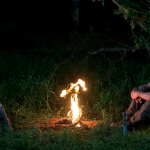Editor’s Note: Spoiler alert if you’re not up to date on Breaking Bad.
Breaking Bad has always been about the .111958%.
In season one we see a flashback of high school chemistry teacher Walter White at a chalk board discussing the chemical makeup of the human body. He is able to account for 99.888042% of the elements that constitute a human being. Wondering aloud about the remaining .111958%, Walt tells his former love interest that there has “got to be more to a human being than that.” Later in the episode—after Walt has killed a drug dealer—we return to the same flashback where Walt, still trying to account for the missing .111958%, finally wonders out loud, “what about the soul?” Breaking Bad is primarily concerned with the primacy of moral questions to personal identity, and this relationship is embedded within the context of how evil decomposes human nature.
What’s interesting about the formerly beloved high school chemistry teacher turned increasingly horrifying, meth-producing mad scientist is the sense in which his moral decline–his slow disintegration as a human being–has been the result of a spectacular imaginative failure. In the aforementioned flashback, Walt is willing to imagine that the missing percentage of the human body’s chemical makeup is the soul. Yet, as Walt breaks bad, he must increasingly–and ironically–put his imagination to ever more sensational use even while the goodness of the motivations underlying his imagination is deteriorating. Consider the irony of his initial decision: to use his scientific acumen to produce meth in order to make money for his family is a creative feat, but to be convinced that it’s the only or best option is uninspired to be sure.
And so one of the key plot elements driving the show is Walt’s ability to imagine means of overcoming difficult, sometimes threatening situations. His ability to transcend the potential consequences of entering the world of meth production is usually boosted by his superior scientific knowledge. Need to dispose of a couple of dead bodies without leaving any trace? Grab some hydrofluoric acid and a polyethylene storage bin! Need to send an explosive message to a violent drug dealer? Disguise some fulminated mercury as crystal meth! Need to secretly poison your partner’s girlfriend’s son to frame a drug kingpin and regain your partner’s trust? A Lily of the Valley plant will do the trick! Jesse is so consistently enamored by Walt’s capacity to imagine solutions that he comes to expect that they will overcome even the most impossible obstacles. But Walt’s imaginative feats also often reveal his decay by showing the limiting, self-enclosed purposes which accompany pride’s feeble imaginative outlook. Walt’s imagination seems increasingly restricted as Walt grows increasingly self-absorbed.
In the first episode of the latest–and final–season, Walt has to cook up one of his most inventive escapes, when his DEA brother-in-law Hank appears on the verge of discovering Walt’s true identity as a meth producer. In the aftermath of Walt’s triumph over Gus Fring, the FBI now has a laptop with surveillance video which would connect Walt, Jesse, and Mike to Gus’s underground meth operation disguised as a Chick-fil-a knockoff. While Mike resigns himself to the fact that the trio will have to run away or get caught, Jesse knows better than to doubt his partner in crime. Need to make sure a Dell laptop that is securely locked up in an investigative evidence room is destroyed? How about a powerful magnetic contrivance wrapped in a get-away truck that would leave Danny Ocean in awe!
Leaving the scene, Jesse is a true believer, while Mike is still a skeptic. Walt proclaims that the mess they left behind is “untraceable.” Mike counters, “You’ve got all the answers?” After Walt solemnly pronounces that “it worked,” Mike questions his pretension to omniscience: “We’re supposed to take that on faith? Why? How do we know?” In Walt’s reply, we know that his villainous metamorphosis is all but complete: “Because I say so.” Walt’s answer reveals the grand flaw of his imaginative power: his raging desire for self-sufficiency.
In the final few episodes of the first half of the fifth season, Walt’s imaginative brilliance–though spectacular–does show its fatal deficiency all the more clearly. Struggling to come up with the materials to maintain a steady flow of production, Walt is forced to come up with an elaborate plan to rob a train transporting a shipment of methylamine. It may be the pinnacle of Walt’s megalomaniacal escapades. But in the aftermath of a successful steal, the whole plan goes awry when a young boy on his bike sees the crew, and Todd, Walt’s young associate, instinctively pulls out a gun and shoots the boy in the head out of the fear that the mission could be compromised.
While Jesse is inconsolable over the boy’s death, Walt’s conclusion–that Todd was merely doing what was necessary–comes a little too easily. Walt says that he is agonizing over the incident, but his demeanor suggests a brazen callousness. Walt’s hardened response is depicted well when, after he tries to assuage Jesse’s conscience on the matter, he can be heard whistling a little too gleefully as Jesse–increasingly mortified by his formerly mild-mannered science teacher’s behavior–is leaving the cook site.
Walt’s imaginative failure is perhaps nowhere more apparent than in how his response to the child’s death contrasts with his response when faced with the decision of whether or not to kill the drug dealer. Back in the third episode of season 1 (“And the Bag’s in the River”), there’s a scene in which Walt sits on a toilet making a comparative list of the pros and cons between letting the man live and taking his life. His first consideration is under the “Let Him Live” column, and it reads, “It’s the moral thing to do.” But the kind of imaginative reasoning displayed in that scene no longer enters into Walt’s moral calculus. Previously, Walt was burdened to imagine non-violent choices; now, as he breaks bad, the burden is progressively lighter, the moral options are more unimaginable, and, thus, the perceivable options are fewer. The collateral damage has become necessary to suit Walt’s increasingly solipsistic fancy; he must be free in the limiting way that he defines freedom.
Walt may be able to imagine every scenario necessary to perpetuate his self under the guise of protecting his family, but here’s what Walt has not been able to imagine: he can’t imagine a scenario in which he might “win” by confessing his crimes. He can’t imagine that he might be damaging his family more than protecting it. He can’t imagine that his freedom might be defined by humbling himself rather than basking in the alleged triumph of total self-sufficiency. He can’t imagine that his cancer might not be the very end of him. He can’t imagine that there might be a kind of spiritual cancer worse than the physical disease. And in what might be the initial key to Walt’s essential downfall, he can’t imagine accepting money for treatment from his successful old partners without it being a fatal blow to his kingpin monstrosity, Pride.
Walt can’t imagine that the .111958% is that which governs the 99.888042% unto life or unto death.
Unfortunately for Walt, he also can’t imagine that he is most essentially enslaved to the Law, which–embodied by his persistent DEA brother-in-law Hank–seems to be the reality which could finally confront his fantastically deluded imagination with the harsh light of revelation. It seems to be the setup for the show’s final go around: Walt’s libertine self versus humanity’s natural limits. Unless Walt can imagine a freedom more essential and fulfilling than total self-sufficiency and escape, then the final suicide of his soul appears inevitable. The question, then, is how will this show end next summer? Need to imagine a conclusion where justice and mercy meet? There’s a death, burial, and resurrection to participate in. Otherwise, we probably can’t imagine an ending that isn’t like that movie where everyone dies in the end.
Illustration courtesy of Seth T. Hahne. Check out his graphic novel and comic review site, Good Ok Bad.











